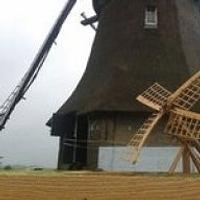Share your craft projects
Make new craft buddies
Ask craft questions
Blog your craft journey
article
[Image]
Just some pictures of putting all the parts together
[Image]
Lower end of the post fitting the "onder tafelment"
[Image]
Top end of the ...
To support the tube (koker) and to give strength to the lower part of the windmill there are "kokerbalken" (girders?). They form a bent together wi...
With the posts and the girders made, its time to make the "korbelen". These knee braces help strengthen the construction of the lower part of the w...
After finishing the kokerbalken en korbelen the tube can be fitted
[Image]
Measuring the placement of the tube
[Image]
Cutting the recess
[Image]...
The "boventafelment" is also anchored on the beams with 4 metal anchors. On the drawing these are placed on the outside. But I want to be able to t...
To add more stiffness to the construction of the housing of the windmill there is additional bracing. These crosses are not in the fields where the...
This mill has a concrete base and brick stone walls. According to annotations on the drawing the mill wasn't built like this. It had a stone founda...
The Water that is pumped by the mill has a exit called "waterloop". It houses a door to keep the water on the high side of the mill out (like a hor...
The "Stoelbalk" and the "wervel" are the parts on which the main spindle rests. The wervel is made so it can be moved to fine tune the running of t...
[Image]
To prevent the mill from blowing over it is anchored to the concrete foundations. In my model i'm not using any concrete and this windmil...
The lower part of this mill is cladded in wood. I want the cladding to be removable so i can access the inner works and also to be able to show wha...
The screw's main baring is what's next on the to-do list.
[Image]
In the real world the main baring is usually made of stone, But occasionally it...





















